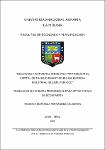Decisiones financieras eficientes para reducir el capital de trabajo invertido en una empresa industrial de Lima, Perú 2021

Fecha
2022Autor
Fernández Calderón, Yessenia Marisela
Metadatos
Mostrar el registro completo del ítemResumen
El trabajo se realizó con el objetivo de determinar la mejor alternativa para reducir el capital de trabajo de la empresa Industrias Amaris S.A. a diciembre del 2021, para lo cual se analizó la posibilidad de variar los indicadores Rotación de cuentas por cobrar en días (RCCD) y Rotación de cuentas por pagar en días (RCPD). En base al concepto de Benchmarking se utilizó al competidor directo más eficiente de cada línea de negocio como referencia y objetivo de los plazos promedios de cobro y de pago. Se encontró que, respecto a las cuentas por cobrar, las líneas Tejidos y Cerámicos podían reducir el capital de trabajo si aceleraban las cobranzas en 17 y 13 días respectivamente; tras varias negociaciones con los clientes y propuestas de descuentos por pronto pago, ambas líneas llegaron a reducir el periodo promedio de cobro entre 7 y 8 días. En las cuentas por pagar, el objetivo fue extender los plazos de pago de las líneas Tejidos y Químicos en 9 y 28 días respectivamente; pero los principales proveedores rechazaron la solicitud argumentando que la pandemia también los había afectado, la empresa priorizó la buena relación con ellos y desistió de su intento por extender los plazos de pago. Se concluye con que la mejor opción, y única factible ahora, para reducir el capital de trabajo invertido es cambiar la rotación en cuentas por cobrar. Adicionalmente, se sugiere mejorar las estrategias de cobro y analizar las variaciones en la rotación de inventarios después que se ejecuten las inversiones planificadas para este año, como la compra de una nueva empresa y la ampliación de una planta de producción. The work was carried out with the objective of determining the best alternative to reduce the working capital of the company Industrias Amaris S.A. to December 2021, for which the possibility of varying the indicators Rotation of accounts receivable in days (RCCD) and Rotation of accounts payable in days (RCPD) was analyzed. Based on the Benchmarking concept, the most efficient direct competitor in each line of business was used as a reference and target for the average collection and payment terms. It was found that, regarding accounts receivable, the Textiles and Ceramics lines could reduce working capital if they accelerated collections by 17 and 13 days, respectively; after various negotiations with customers and proposals for discounts for prompt payment, both lines managed to reduce the average collection period to between 7 and 8 days. In accounts payable, the objective was to extend the payment terms of the Tissue and Chemical lines by 9 and 28 days, respectively; but the main suppliers rejected the request arguing that the pandemic had also affected them, the company prioritized the good relationship with them and gave up its attempt to extend the payment terms. It is concluded that the best option, and the only feasible one now, to reduce the working capital invested is to change the turnover in accounts receivable. Additionally, it is suggested to improve the collection strategies and analyze the variations in inventory rotation after the investments planned for this year are executed, such as the purchase of a new company and the expansion of a production plant.
Colecciones
- EPL-EP Tesis [170]
El ítem tiene asociados los siguientes ficheros de licencia:


